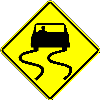Global Navigation

Main Navigation
Sub-Navigation

Content
Anytime we are putting down the road, there is some amount of traction used by this accelerating force even at a constant speed. As power is applied to the rear wheel, it is the traction that keeps the bike moving. The interesting thing about accelerating traction is that it is the only traction force that is not present on the front wheel. Obviously, the drive to push the bike forward is applied to the rear wheel by the belt, chain or shaft connecting the rear wheel to the power plant (engine and transmission.) So accelerating force is one of the users of our traction.
Another user of traction – Braking
The second traction user we want to examine is braking. When we apply our brakes, we expect our motorcycle to stop, or at least to slow down. Again it is the friction between our tires and the road that makes this happen. As we restrict the movement of the wheels through the use of our brakes, friction causes our bike to slow. We call this braking force, another user of our traction. We may have experienced what happens when we try to use too much traction while braking. The most common result was probably a rear wheel skid, although it is possible to skid the front wheel as well.
It's interesting to note that, from a traction perspective, it doesn't matter how we restrict the wheels from turning. The presence of braking force is still there. The normal method of braking involves pressing the brake pads against the brake rotor (or shoes against the drum) to restrict the rotation of the wheel as we depress the brake pedal and squeeze the front brake lever.
Sidebar
Footer
Copyright 1996-2015 Chuck Miles All Rights Reserved
All information on this site, including all articles, are copyrighted materials belonging to Chuck Miles.
Design: Made in Austria | Author: G. Wolfgang



